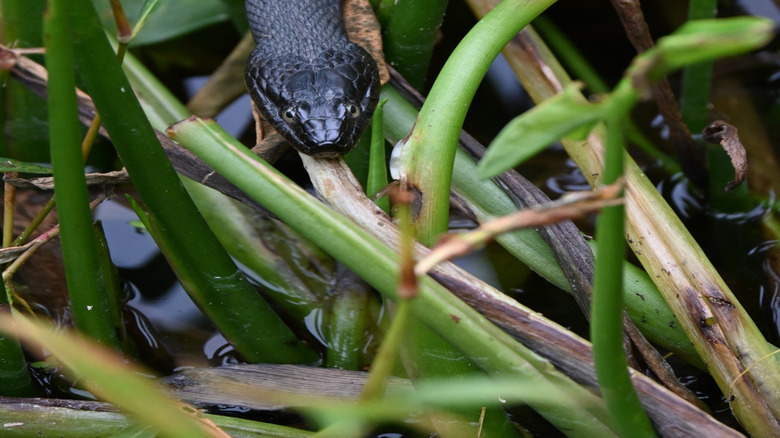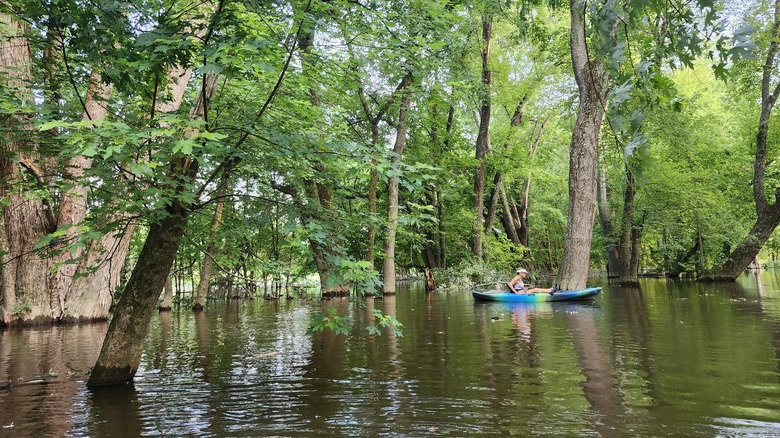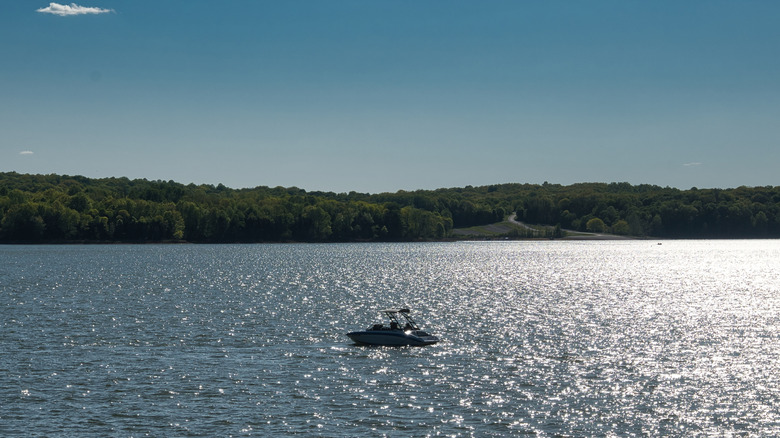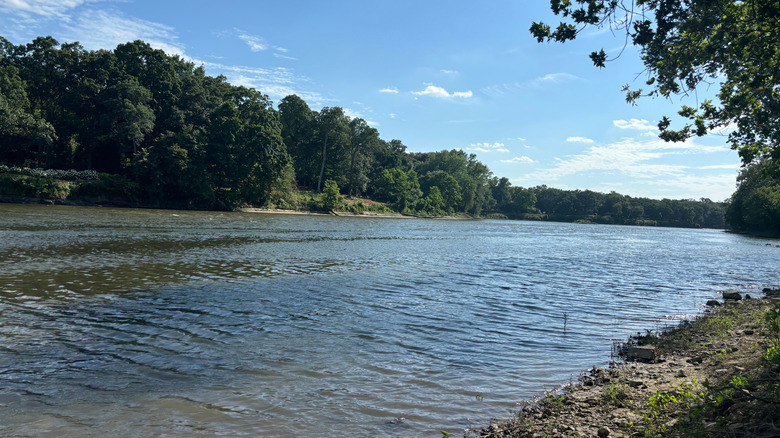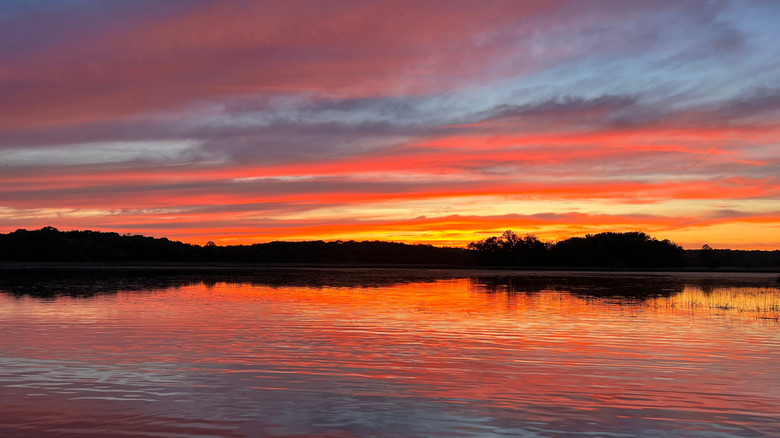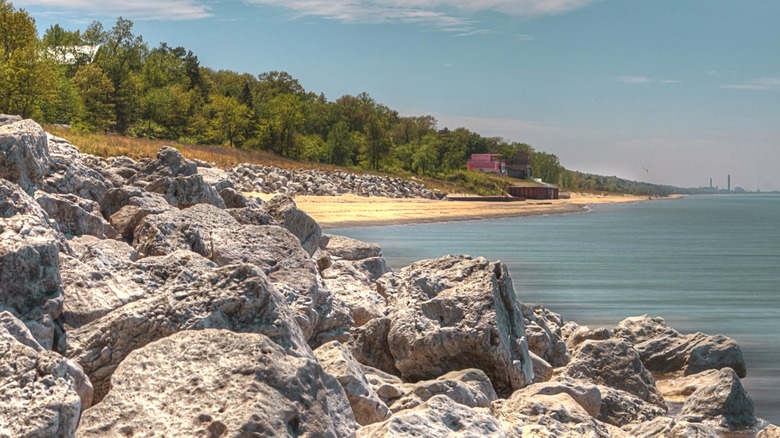Indiana's Most Snake-Filled Waters Are Not For The Faint Of Heart
While Indiana is known for its charming rural towns, it also has beautiful lakes that appeal to nature-lovers across the country. Popular spots such as Lake Monroe, Patoka Lake, or even the renowned Lake Michigan are all top contenders for travelers making a trip to indulge in the state's waterfront beauty. Of course, when you consider which place to visit, snake-filled lakes are probably not what you have in mind. However, once you've plotted out your journey and planned your lake day activities, you may want to take note of which waters are most likely to offer a run-in with some local snakes.
Indiana has a wide variety of scenic lakes, reservoirs, and other bodies of water that, while relaxing, are ideal habitats for snakes. Luckily, water snakes typically aren't dangerous, and they seek out quieter areas around water for their dwellings rather than populous swim beaches or busy boat launches. In the entire Hoosier State, there is only one venomous species of snake that occupies rivers, marshes, or lakes. When visiting bodies of water, look out the Eastern cottonmouth snake. This species is sometimes referred to as the water moccasin and is a pit viper that lives most of its life by water. It is commonly found in Southeastern parts of the U.S. like Florida as well as in some Midwestern locations. In Indiana, it is an endangered species.
There are a few other venomous species of snakes that don't live in the water but may be found near it, including timber rattlesnakes, copperheads, and Eastern Massasauga rattlesnakes. It's a good thing for travelers that the majority of the snakes found in Indiana's lakes aren't likely to harm you. But if you're a snake-phobe or you're just curious about where these animals usually linger, here are a few of the most snake-filled lakes in Indiana.
Lake Monroe
With around 10,000 acres of water, the reservoir of Lake Monroe is the largest lake in Indiana. It attracts over a million visitors per year and is home to several species, including the endangered clubshell mussel, Indiana bat, and a few snakes.
Lake Monroe is home to both venomous and nonvenomous snakes. The harmless species you might encounter include the plains garter snake and common garter snake. Typically, these snakes can be found hidden in marshy areas, where they eat tadpoles. They're nonvenomous, so don't worry if you see one — it's likely more scared of you than you are of it. Other snake species found in this lake include the Eastern racer and Eastern hognose snake. While the racer is nonvenomous and doesn't pose a threat to people, the hognose isn't so harmless. This snake not only looks quite scary, with its thick black body and wide head, but its bite is also slightly venomous, known to cause swelling and bruising.
Two venomous snakes that have been found near the lake are timber rattlesnakes and copperheads. You can spot a timber rattlesnake by its heavy body (it's the heaviest snake in the state), brown striped camouflage pattern, and black tail. Timber rattlesnakes usually prefer forested areas. Copperheads, meanwhile, are the most common venomous snakes in Indiana. Their natural habitat is high, dry, and densely forested areas where there are oak trees and hickories as well as a nearby waterway. As a result of these preferred environments, these snakes are rarely seen in lakes, though the copperhead looks a lot like two harmless Indiana snakes: the common water snake and the Eastern milksnake. These species don't attack unless threatened, so as long as you leave them alone, you should be fine.
Patoka Lake
An excellent recreation area in southern Indiana, the 8,800-acre Patoka Lake is one of the state's best places to reset in nature and has often been compared favorably to Lake Tahoe. Even with this reputation, the shores here are usually uncrowded, meaning visitors will have plenty of space to indulge in the open water. It's also a popular spot for boating, swimming, and fishing, despite the snakes lurking beneath the surface.
Patoka Lake features a population of venomous and nonvenomous snakes. One species found here is the nonvenomous Northern water snake — aka the common water snake. It usually enjoys swimming in the deeper parts of the lake, but you can also find it lazing around on the shore and enjoying the sun. Other nonvenomous snakes commonly spotted at Patoka Lake are common garter snakes and gray ratsnakes, which can be confused for copperheads due to their brown striped patterns.
Kankakee River
Kankakee River is known for its smooth waters and beautiful forests. Every year, visitors flock here to fish and canoe in the lake. Its surrounding state park is popular among visitors, too, who love using its more than 200 campsites and multiple picnic areas. But this 57-mile-long stretch of abundant nature in northwest Indiana also has a catch: Many visitors have reported seeing snakes here.
Some notable local species include Eastern, common, and plains garter snakes as well as Northern water snakes. Luckily, all of these species are nonvenomous, but you're likely to see one or two wriggling around your campsite if you're pitching a tent here. Some of these species can grow up to 5 feet long, and they like hanging out by the water's edge, where they eat frogs and insects, so keep an eye out when visiting the river. Other species that call the state park home include Eastern hognosed snakes, milksnakes, brown snakes, and ribbon snakes, which are all nonvenomous. The Western hognosed snake has also been identified here, and it's equally as venomous and defensive as its Eastern counterpart. Bull snakes also live in the park — this long and striped species isn't venomous, but it can be commonly confused with a rattlesnake since it also shakes its tail when threatened.
Chain O' Lakes State Park
Indiana's underrated Chain O' Lakes State Park showcases nine connecting lakes, each stunning in their own way. Located outside the northeastern Indiana town of Albion, the park is a great place to enjoy paddling, boating, or swimming through multiple lakes in one go. You can even extend the fun by camping overnight or visiting the historic sites and trails on site. The set of lakes is spectacular to visit year-round, but it's especially popular in the summer months.
Unfortunately for the skittish among us, Chain O' Lakes State Park is also home to many species of snakes. One of the most common species found here is the Northern water snake, but you don't need to worry about them. Though their impressive size (they grow up to 5 feet in length) might intimidate visitors and they're regularly spotted throughout Indiana's bodies of water, Northern banded water snakes are not only harmless but also helpful to their surrounding ecosystems, as they aid in controlling fish populations. Just don't mistake them for venomous cottonmouths — Northern water snakes tend to be just as dark, but the banded species has lighter stripes across its body, and the harmless copperbelly water snake's underside is a telltale rusted copper color. Other smaller nonvenomous species, like garter snakes, are also commonly found in Chain O' Lakes State Park.
Lake Michigan
Lake Michigan, situated along the state's northwestern border, is one of the most famous and picturesque lakes in America. Visitors love it for its wide range of activities, such as boating, fishing, and kayaking. Unfortunately, the lake is also home to many species of snakes.
The only venomous snake you're likely to encounter here is the Eastern Massasauga rattlesnake. While this venomous snake may lurk in the lake, it prefers to remain undetected and hidden, often concealing itself under vegetation or woody debris. It is unlikely to act viciously and tends to flee when discovered by humans. If it's threatened, the snake might rattle its tail as a warning. These snakes resemble Northern banded water snakes, but you can recognize them by their diamond-shaped heads and their rattle, which sounds like an insect buzzing. They tend to grow up to 2 to 3 feet long. Their bites aren't always venomous, but they should always be treated like an emergency. Like many of the other lakes in Indiana, the area also sees other nonvenomous snakes, such as garter snakes and Northern water snakes.
If you're wary of encountering creatures in the water, you can always explore Lake Michigan from its downright cozy secret island. Of course, if shorefront adventures are a major part of your travel itinerary, you'll probably want to learn even more about Midwestern wildlife. Stay informed with this explainer on which snakes reside in Michigan's lakes.
